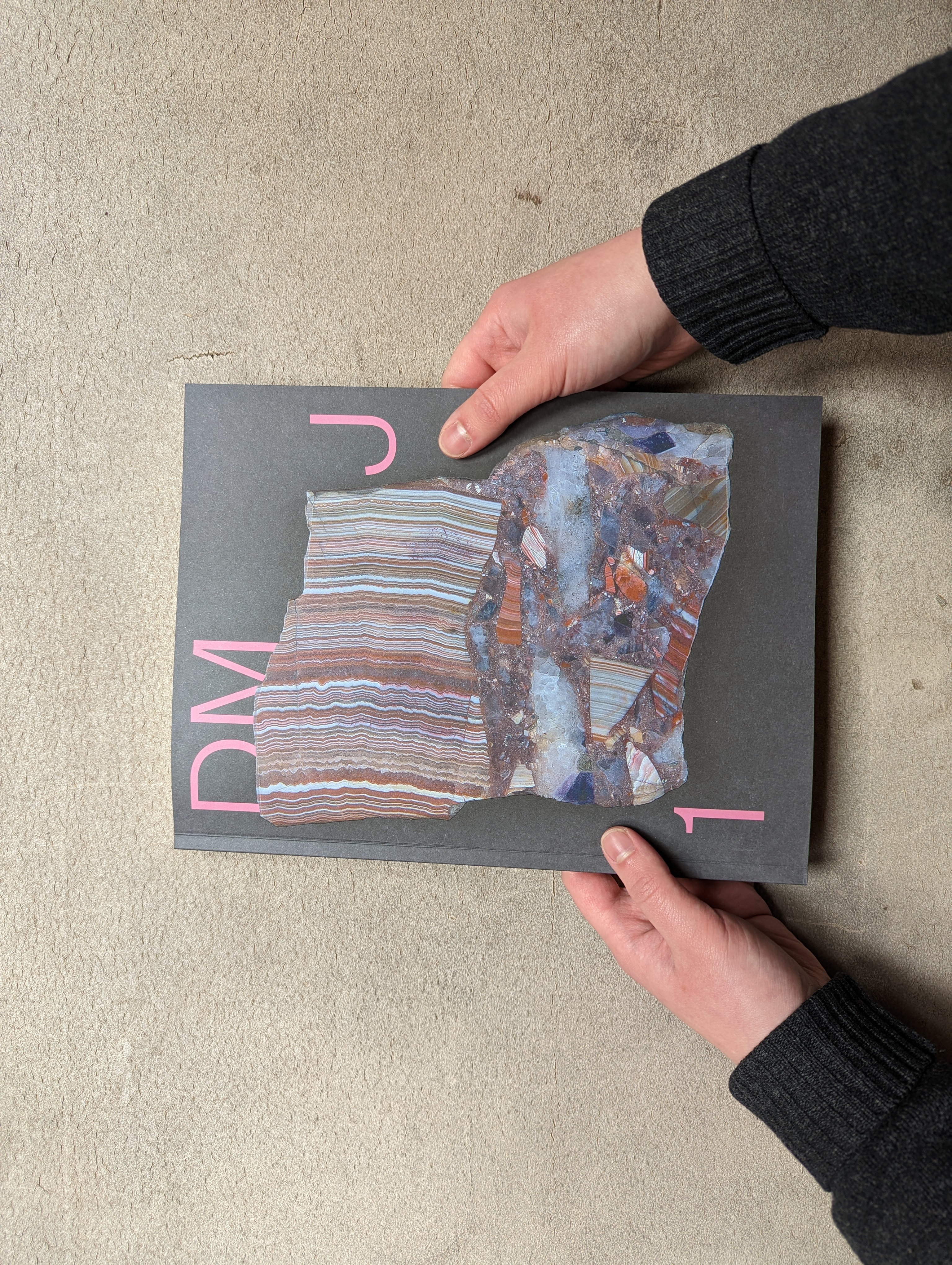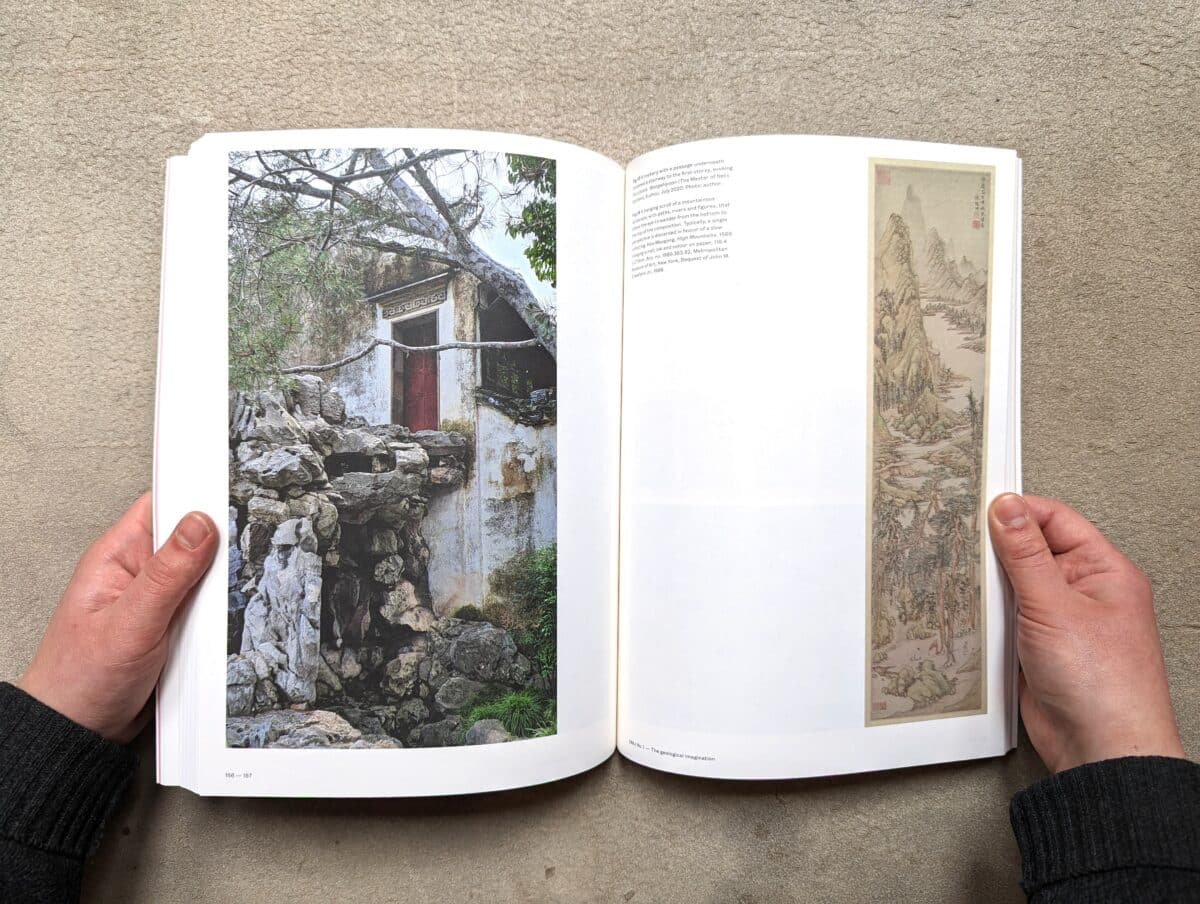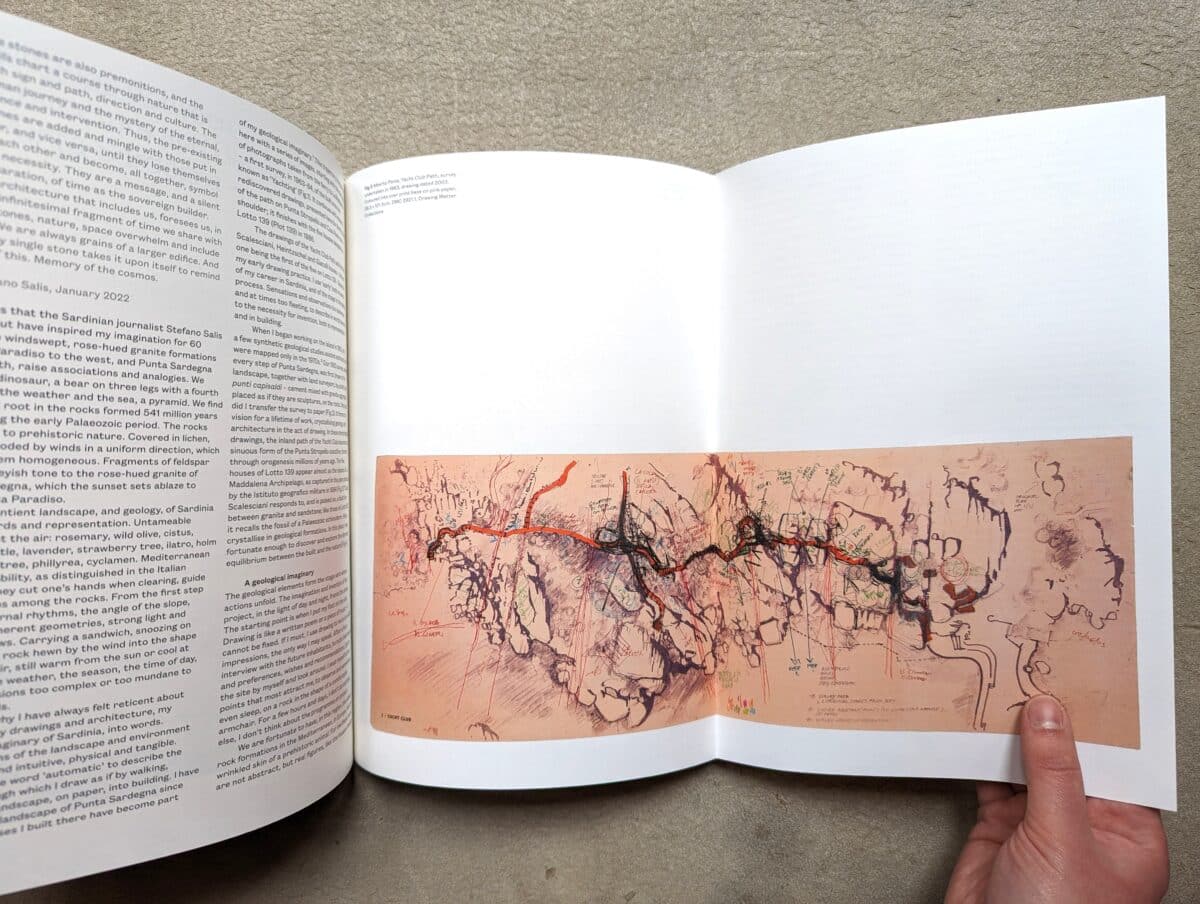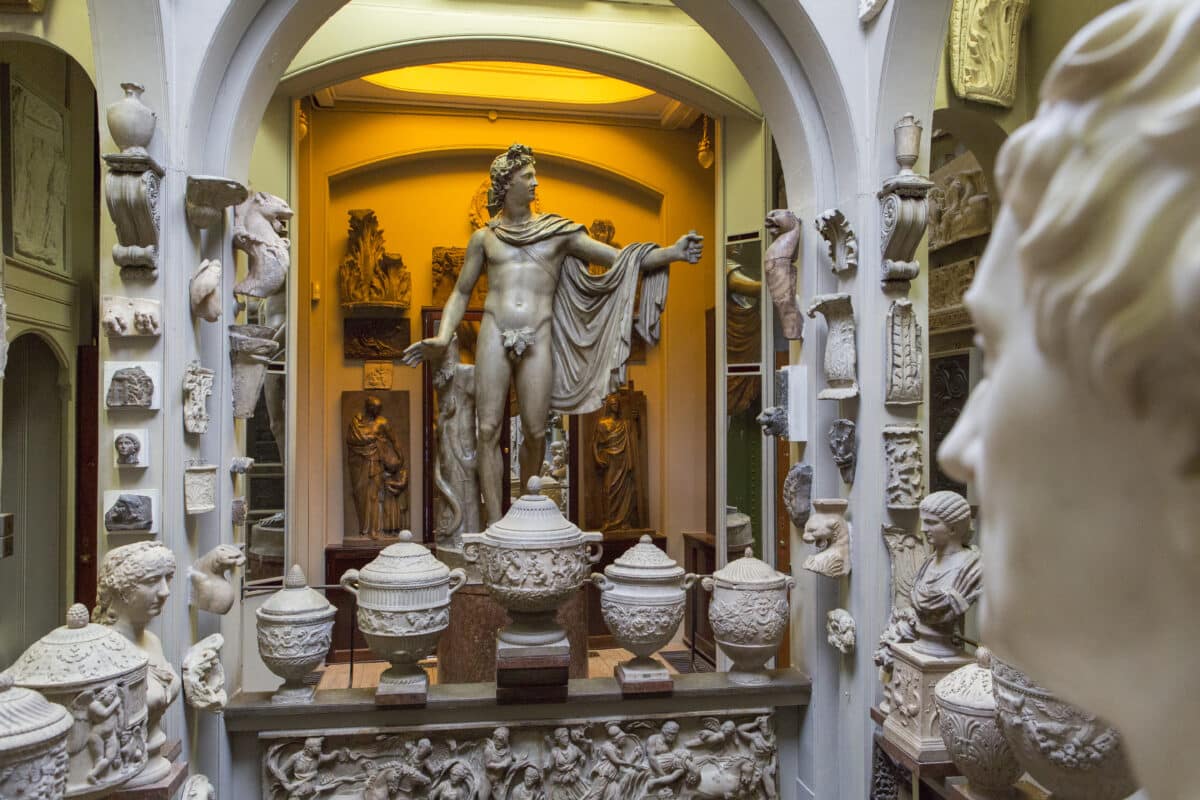DMJ 1 – The Geological Imagination
– Mark Dorrian and Kurt Forster

DMJournal–Architecture and Representation is a new peer-reviewed publication dedicated to the exploration of practices, histories and material cultures of drawing in architecture and related fields. The first issue The Geological Imagination has now been published.
Purchase Issue 1 / Purchase a subscription to Issues 1–3


Editors’ Introduction
Sir John Soane imagined turning into stone. The episode occurs at one point in his curious manuscript Crude Hints Towards an History of My House, written in the late summer of 1812, at a time of personal crisis. In this, Soane adopts the persona of an Antiquary who speculatively discourses on the enigmatic remnants of his house in Lincoln’s Inn Fields. While this is apparently a voice from the future, it seems also to have a foot in the time of writing, given that demolition and building works were then currently in progress at No.13, thus poising the edifice ambiguously between ruination and reconstruction.
In the text, the Antiquary rehearses various conjectures regarding the mysterious remains, while to the side two ranks of marginal comments, seemingly by other interlocutors, supplement the main narrative, at times concurring with its suggestions and at others disputing them. At one point the Antiquary reports a belief that the house may have been the residence of ‘some Magician’, a ‘necromancer’ who has become transformed into marble and as such survives in the form of a statue positioned ‘in the centre of one of the Chapels’. [1] An exclamatory but laconic marginal note reads: ‘This is not extraordinary. Lot’s wife for looking behind her we all know was changed into a pillar of Salt & remains so to this day!’ [2] The statue was likely to have been derived from the Apollo Belvedere cast that had come into Soane’s possession the previous year and that presided over the Dome Area in his museum. Helen Dorey has emphasised Soane’s apparent identification with the statue, pointing out how, in 1833, following the passing of the Soane Museum Act of Parliament, the architect relocated his portrait bust, executed by Sir Francis Chantrey, to a position in the Dome Area where it directly faced the effigy of the god. [3] This petrification of the magus, continues the Antiquary, was said to be in retribution for the destruction of statues of the Apostles supposed to have occupied the twelve blind and empty niches that punctuated the rear façade of Soane’s property. However, the Antiquary observes, others argue that his crime was not one of destruction, but of the transformation of the Apostles ‘by the power of the diabolic arts’ into female statues, of which some indeed remain. ‘I judge because the transformed statues are in dimension sentate to the niches’, our commentator-in-the-margins approves. [4] Perhaps these are intimations of the caryatid statues that Soane would purchase in November 1812 for the front of his house, which were anticipated in drawings made in July and August, when he began Crude Hints. If this is the case, then one kind of metamorphosis comes to beget another, the transformation of the Apostles of Christ into pagan maidens being revisited upon the enchanter in his fossilisation. Later in the text, the fabled apostolic statues arise once more, although this time the inference is that, as they may have been made from precious metal, they have been looted or perhaps suffered at the hands of fanatical iconoclasts. Still, the charge levelled at the thief – who is characterised as ‘some daring impious violator of the most sacred rights of religion’ – seems primed to recall for the reader the magician already encountered. [5]

How might we think about this peculiar work of the geologic imagination, this dream of turning into stone, which seems so entangled with intimations of artifice, catastrophe, burial and excavation? On one hand, it looks like a reversal of the kind of situation we find in the Pygmalion myth and related stories, in which the inertness of the inorganic – or perhaps something frozen – is animated by some act of affection or desire. Later in Crude Hints, as the author turns towards a more direct account of the house of the architect and the predicament of its inhabitant, Soane writes of attacks directed at him (to do with controversies stirred by his Royal Academy lectures) and his agonising disappointments with his sons, noting that ‘his lively character became sombre – melancholy, brooding constantly over an accumulation of evils’. [6] In effect, he became stony. At the same time, this imagining of petrification and, more generally, ruination was related to his shipwrecked dream of laying the ‘foundation of a family of Artists’ who, dwelling ‘in this place from generation to generation’, would raise ‘Architecture to its meridian splendour’. [7] Thus the fall of the dreamt-of dynastic house mingles with, and is symbolised by, the ruination of its seat, which becomes a kind of porous archaeological site akin to that emblematic necro-topography and locale of geological catastrophe, replete with its own petrified figures, Pompeii. A large cork model showing the excavations at Pompeii c.1820 would come to take its place as the major installation in Soane’s model room. [8] In the fable of the enchanter, Soane’s petrification by sorrow turns into a kind of auto-monumentalisation that commemorates the failure of his hopes. Soane becomes stone; his marmorealisation memorialisation; and his fossilised body a genealogical dead-end – at least as far, that is, as his hopes to progenerate a ‘race of Artists’ went. [9]
And yet, in parallel with all this, there is perhaps something else in play in this necromancing of the stone. For the motif surely conveys, at the same time, a strangely ecstatic and even consoling meaning, as if metamorphosis was a vehicle of apotheosis. Here the architect merges with and, in effect, becomes architecture itself, uniting with an object of desire that draws him across the threshold between life and stone in the reverse direction to that more usually celebrated in our stories. If the statue in the ‘Chapel’ area is indeed the Apollo Belvedere, then we are given an image of the architect merging with the figure of the god of light and of culture, whose idealised form – pristine and pellucid – recalls the Apollonian plaster models of ancient temples fabricated by François Fouquet that Soane would come to purchase in 1834 and display alongside his pitted and seemingly time-ravaged miniatures of cork. [10]
Into Soane’s library a number of books on geology were to make their way. These included a second edition of An Inquiry into the Original State and Formation of the Earth (1786, 1st ed. 1778) by John Whitehurst, a member of the Lunar Society, and A Comparative Estimate of the Mineral and Mosaical Geologies (1825) by the ‘scriptural geologist’ Granville Penn, a volume presented to Soane by its publisher. As part of the works at the time of writing of Crude Hints, the architect located two spiralling ammonite fossils on the roof above the Monument Court, precursors of architecture akin to those that would be depicted by J.M. Gandy in his painting Architecture: its Natural Model (exhibited in 1838 and illustrated in the pages below). [11] Soane would come to acquire a bust of Baron Cuvier, the celebrated French natural historian whose studies of palaeontological discontinuity led him to posit a catastrophist theory of earth history based on periodic cataclysmic ruptures.
Soane’s Crude Hints was written in the wake of the great geological controversies that had erupted during the 18th century and that challenged understandings of the age of the earth extrapolated from scriptural sources. Central here was the contribution of the Scottish natural scientist James Hutton, who understood geological processes observable in the present to be active over immense time-spans and whose thermodynamic vision crucially recognised the role of volcanism working in relation to erosion, sedimentation, and pressure and uplift. His ‘Theory of the Earth’ was first articulated in papers in the 1780s and later popularised by his friend John Playfair in Illustrations of the Huttonian Theory of the Earth (1802). The figurehead of the Neptunists, who opposed Hutton’s Plutonism, was the Freiberg-based geologist Abraham Gottlob Werner, who believed that the earth had once been covered by an ocean from which rocks were precipitated. Refuting the idea of a molten core, the Neptunists held that lava was a result of subterranean coal deposits burning. In the description of a temple dedicated to Werner that is drawn from John Paris’s Philosophy in Sport Made Science in Earnest (1827) and reproduced in this issue, the dispute is symbolised by carvings showing ‘a contest between Pluto and Neptune, in which the watery god was seen in the act of wresting the burning torch from the hand of his adversary, in order to quench it in the ocean’. [12]
In addressing this inaugural issue of Drawing Matter Journal to the ‘geological imagination’, we aimed to investigate the imbrication of thinking in architecture and art with matters of the earth, and to explore the kinds of graphic inscription to which this has given rise. Moreover, in doing so we wanted to attend to the much-debated concept of the Anthropocene and the way it has both given a new centrality to geology in critical cultural discourses and led to different kinds of questions being addressed to historical materials. This is evident in various ways across the contributions to this issue. Nicholas Boyarsky’s and Michael Chapman’s papers explore aspects of the iconography of the extraction of carboniferous material – Boyarsky in relation to the condition of tar as a substance that lubricates our fossil-fuelled mobility but whose stickiness can also bring things to a halt in time and space; and Chapman through his investigation of drawings related to the description and exploitation of the coal seams of Newcastle in Australia. Yue Zhuang further broadens the reflection on mines via her consideration of the poetics and politics of Alexander Pope’s reconstruction of his grotto in Twickenham as a mine. Zhuang describes the watery and fiery motifs of Pope’s redoubt in terms of a poetic ideal of regenerative transformation, relating it to – among other things – the Jesuit Athanasius Kircher’s Mundus Subterraneus (1665), and reproduces its remarkable engraving of a section of the terrestrial globe, with a network of fiery channels linking its inner furnace to a ring of surface volcanoes. Questions of volcanic vibration and somatic listening animate Adam Bobbette’s paper, which explores the work and legacy of the American volcanologist Frank Perret. While we are latterly familiar with the seismograph as a species of drawing apparatus, Bobbette shows how Perret experimented with ways of ‘taking the pulse of the earth’, inscribing vibrations within his sensorium through expanded practices and technologies of listening. The volcano reappears in Guillaume Othenin-Girard’s considerations of the Armenian glkhatun, a form of dwelling that he relates to the mythically invested volcanic mass of Mount Ararat. Othenin-Girard shows how complexes of these remarkable semi-subterranean constructions merged with the ground to structure material-cultural landscapes of extraordinary porosity, intricacy and attunement.
Ethan Loo’s contribution shifts our attention to China, delicately explicating the ‘geo-religious phenomenon’ of scholar’s rocks, whose fascinating forms served as heightened objects of contemplation and imagination of the literati élite. Alberto Ponis’s account of his life and work in Sardinia gives us another sort of life lived with rocks, one that shows an intimacy and conviviality with them comparable to Chinese cases. As the theatre critic and scholar Qi Biaojia – who was alive during the turmoil of dynastic change at the end of the Ming period – befriended ‘Cold Cloud’ rock in his garden, so Ponis finds a kind of hospitality amongst lithic presences, one articulated through his architecture: ‘I incorporate rocks into the walls’, he writes, ‘as if I were looking for a kind of kinship.’ Finally, the media theorist Bernard Siegert returns us to the artist Robert Smithson, whose 1969 Asphalt Rundown we have already encountered in Nicholas Boyarsky’s contribution. Siegert examines Smithson’s map constructions, relating them to his thinking on crystals and exploring his subtle unpicking of anthropocentric perspectivalism through the use of a polar grid.
In addition, around these long-form articles are dispersed shorter pieces that we describe as ‘interpolations’. These are sometimes purely documentary – for instance, samples from the collection of siliceous minerals that John Ruskin prepared and presented to St David’s School, in Reigate, Kent; a letter from the architect of Napoleon’s tomb to his supplier of marble; J.M. Gandy’s description of architecture’s ‘natural model’ – and sometimes interpretative – Nicholas Olsberg on marble paving by William Butterfield; Martin Bressani on Viollet-le-Duc, Mont Blanc and crystallisation; Iain Boyd Whyte on Bruno Taut’s Alpine Architektur; and Niall Hobhouse on early travellers’ accounts of the rock-hewn tombs of Petra.
Taken together, we hope that the various deposits in this first issue of Drawing Matter Journal will, in their assorted conjunctions as well as their unconformities, provide rich materials for thinking about the geological imagination in art and architecture and the way it has – not least through questions of scale and time – exerted its own kind of pressure upon conventions of representation in ways that have, and that will continue to, transform them.
We are now seeking proposals for contributions for the third issue of DMJournal, that explore the relations between drawing and storytelling. Click here for more information.
Notes
- Sir John Soane, Crude Hints Towards an History of My House in Lincoln’s Inn Fields (Oxford: Archaeopress Publishing Ltd, 2015), 22.
- Ibid., 22–23.
- Helen Dorey, ‘Crude Hints: an introduction’, in ibid., 1–16 (2, note 2).
- Soane, op.cit., 23.
- Ibid., 26.
- Ibid., 30.
- Ibid.
- See John Elsner, ‘The collector’s model of desire: the house and museum of Sir John Soane’, in The Cultures of Collecting, eds John Elsner and Roger Cardinal (London: Reaktion, 1994), 155–76.
- ‘… that the filii filiorum of his loins might, smitten with the love of Art and anxious to shew their gratitude for the benefits & care & comfort they derived from it, dwell in this place from generation to generation – Alas poor man he flattered himself that a race of Artists would have been raised up …’. Soane, op.cit., 30.
- Helen Dorey finds a precedent for this conjunction of plaster and cork in the model exhibition opened by Louis-François Cassas at 8 rue de Seine, Paris, in 1806. While Soane owned a copy of a printed catalogue of the exhibition, it is not known whether he visited it. See Helen Dorey, ‘The place of models and drawings in Sir John Soane’s house and museum’, in The Routledge Companion to Architectural Drawings and Models, ed. Federica Goffi (London: Routledge, 2022), 80–99 (93).
- Soane’s master, George Dance Junior, had developed an architectural order based on the volute-like form of the ammonite, and of this Soane had an illustration prepared for his Royal Academy lectures (Sir John Soane’s Museum Collection, ref: 24/2/10). One of the marginal notes in Crude Hints refers to the finding of a cornu ammonis, and supposes that this indicates the presence of a temple dedicated to Jupiter (Soane, op.cit., 20).
- [John Ayrton Paris], Philosophy in Sport Made Science in Earnest; Being an Attempt to Illustrate the First Principles of Natural Philosophy by the Aid of Popular Toys and Sports, Vol I (London: Longman, Rees, Orme, Brown and Green, 1827), 10.
